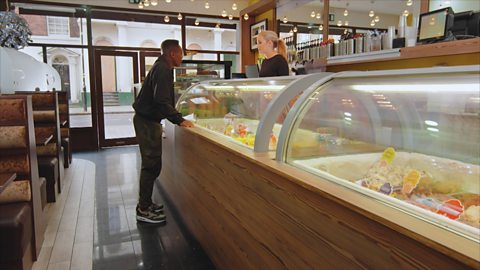UNKNOWN FEMALE #1:Thanks.
BOTH:Love it.
SHOP ASSISTANT:That looks so good on you.
UNKNOWN WOMAN #2:Oh, thanks. Is that the sale price?
SHOP ASSISTANT:No, there's 20% discount on the marked price of all these dresses.
UNKNOWN WOMAN #2:Great! So how much is that, then?
UNKNOWN WOMAN #2:'Well, a percentage can be converted into a fraction or a decimal. Fifty percent equals 50 over 100, the same as a half. And 50 divided by 100 is 0.5.
UNKNOWN WOMAN #2:'The dress is £60, I know that by dividing by 10 I can calculate how much 10% is. And I need to find out what 20% is.
UNKNOWN WOMAN #2:'So, 60 divided by 10 equals £6. And if multiply that by two, I'll get 20%. That means 20% is £12. So, £60 minus £12 equals £48. Which means now, the dress is £48.'
UNKNOWN WOMAN #2:Bargain!
UNKOWN FEMALE #1:'OK, so how much was it originally? The price is now £63 after an increase of 40%. To calculate the new value after a quantity has increased or decreased by a percentage, I multiply the original quantity by the multiplier.
UNKOWN FEMALE #1:'The multiplier is a decimal which is obtained by dividing by 100. 'So, for the 40% increase, 140 divided by 100 equals 1.4. So the multiplier is 1.4.
UNKOWN FEMALE #1:'However, as I want to know what the original price was before the increase, I need to divide by the multiplier. So £62 divided by 1.4 equals £45. So the dress was originally £45.'
UNKNOWN FEMALE #3:That dress is amazing.
UNKNOWN WOMAN #2:I know, I look fabulous, don't I?
UNKNOWN FEMALE #3:Fab!
UNKNOWN WOMAN #2:Smile!
UNKNOWN FEMALE #3:Yeah, oh that one is better.
UNKNOWN WOMAN #2:That is nice.
UNKNOWN FEMALE #1:Hi, that's cute.
UNKNOWN FEMALE #3:Oh my god, look!
LAUGHS
UNKNOWN MALE #1:I can't believe this has got 60 views already. It's been up less than an hour. And 12 likes.
UNKNOWN MALE #2:Look, someone's uploaded another video.
UNKNOWN MALE #1:This one has fewer views, though. Forty view and ten likes.
UNKNOWN MALE #2:But isn't there a higher percentage of likes to the number of views.
UNKNOWN MALE #2:'As a percentage of likes equal to the number of likes divided by the number of views, and then multiplied by 100.
UNKNOWN MALE #2:'So 12 divided by 60 is equal to 0.2, 'then multiplied by 100, equals 20%. 'Whilst 10 divided by 40 is equal to 0.25. And multiplied by 100, equals 25%.
UNKNOWN MALE #2:'So with the first video, 20% of the people that viewed it, liked it. And with the second video, 25% of the people that viewed it liked it.'
UNKNOWN MALE #1:Yeah, but… Mine's better quality. HD.
Video summary
The clip describes how percentage discounts can be worked out without using a calculator.
The scene then progresses to online shopping and calculating the original value using a multiplier.
The final scenes are the number of views of two dance videos; calculating one quantity as a percentage of another and comparing to make judgments.
The word ‘percentage’ is very familiar to us as it is used regularly in the media to describe anything from changes to interest rates, shopping sales and discounted offers or exam results.
Percentages are a useful way of making comparisons. So percentages are very much part of our lives. But what does percentage actually mean?
Now per cent means out of 100 and the word Per Cent comes from the Latin Per Centum and shown by the symbol %.
This is from the series: Real Life Maths
Teacher Notes
The video clip predominantly features normal life situations such as shopping where people may regularly use maths and calculations.
Pupils could be given items in class, and asked to work out discounts or original prices.
Split into two teams, and presented as a competition, the students could be given a percentages quiz.
This clip will be relevant for teaching Maths at KS3/GCSE in England Wales and Northern Ireland. Also at National 4, 5 and Higher in Scotland.
This topic appears in OCR, Edexcel, AQA, WJEC in England and Wales, CCEA GCSE in Northern Ireland and SQA in Scotland.
Algebra. video
A mobile phone deal and a trip to the cinema are used to explain algebra.

Sequences. video
The purchasing of cupcakes is used to explain linear and quadratic sequences.

Pythagoras. video
Cleaning a window and installing a TV are used to explain the theory of Pythagoras.

Probability. video
Predicting the weather and choosing a chocolate are used to explain probability.

Trigonometry. video
A hiker trying to work out the height and distance he's walked uses trigonometry.

Fractions. video
A group of friends sharing a meal is used to explain fractions.

Geometry. video
A clothes designer trying to make an outfit uses geometry.

Finance. video
A man buying a car uses financial planning and investment to work out how much he'll pay.

Ratio and Proportion. video
A cake company demonstrates how ratios and proportions are used to complete an order.
